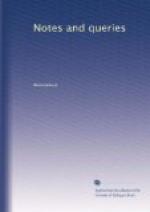It is true that “amongst the letters attributed to Junius, and, in the opinion of Dr. Good, most certainly his production, is one signed Atticus,” {323} which your correspondent proceeds to quote, adding that it is “believed to be the first which appeared signed Atticus.” This is really a little “too bad.” It is known, and ought to have been known to your correspondent before he intermeddled, that Good, though he wrote so confidently in public, had “most certainly” very great doubts in private; that others who have examined the question have no doubt at all; and have, indeed, adduced such strong proofs against Good’s conjectures, that the gentleman now engaged in producing a new edition of Good’s work speaks, in the first volume, the only one yet published, of Good’s “unhesitating affiliation” of these letters, and announces his intention of offering hereafter “strong proof” that the letters signed Poplicola, Atticus, and others, “were not written by Junius.” That there may be persons who believe that the letter quoted was the first which appeared signed Atticus, I cannot deny; but all who are reasonably informed on the subject know that it is not so;—know, as stated not long since in the Athenaeum, that letters signed Atticus appeared in the Public Advertizer from 1766 to 1773—possibly before and after—and that within that period there were at least thirty-seven letters published, from which Good was pleased to select four.
W.
* * * * *
WHITE HART INN, SCOLE.
Having an engraving of this sign, I am enabled satisfactorily to reply to Mr. Cooper’s query (No. 16. p. 245.) respecting its existence. The engraving measures 17 inches and a half long, by 22 wide; it was “Published according to Act of Parliament May the 1st 1740.” In the right-hand bottom corner appears “Jno Fessey Sculp.,” and in the left “Joshua Kirby Delin’t.” It is entitled, “The North East Side of ye Sign of ye White Hart at Schoale Inn in Norfolk, built in the year 1655 by James Peck, a Merchant of Norwich, which cost 1057l., humbly Dedicated to James Betts Gent by his most Obed’t Serv’t Harwin Martin.” The sign springs on one side from a mass of masonry, and was joined to the house on the other: it was sufficiently high to enable carriages to drive under it. As it would trespass too much on your columns were I to particularise each of the figures, I will content myself with giving the printed explanation of them from the engraving, premising that each figure is numbered:—“1. Jonah coming out of the Fishes Mouth. 2. A Lion supporting the Arms of Great Yarmouth. 3. A Bacchus. 4. The Arms of Lindley. 5. The Arms of Hobart, now Lord Hobart. 6. A Shepherd playing on his Pipe. 7. An Angel supporting the Arms of Mr. Peck’s Lady. 8. An Angel supporting the Arms of Mr. Peck. 9. A White Hart, with this Motto (this is the one which ’hangs down carved in a stately




